18″ radomes #5, the 3nm no-one-best-of edition
Sorry I’ve been such a tease about the radar testing. Since entry #4, the wet edition, there’s only been a mention of dome changes and a peek at Broadband on the new Simrad NSE. Frankly, I’m a bit overwhelmed by the research I’ve done so far — which includes hundreds of photos and screen shots — and I still haven’t spent enough time underway, particularly in rain and fog, with the four systems currently installed on Gizmo (above). Patience, please!…
And please don’t expect an ultimate “best radar” declaration; complex devices like these rarely lend themselves to simple rankings, and these 18-inch radomes especially so. The general impressions expressed in #3 are holding true, but consider all the possible subcategories of “best” radar: Best raw target acquisition and resolution performance at close, mid, and far ranges; best automatic tuning (presets help); best power efficiency and start up times; best user interface (with novice, average, and advanced user sub-subcategories); best target tracking enhancements like MARPA and echo trails; best advanced features like dual ranges and scanner speed control; best installation scheme; best integration with MFD; best value…and there may be more! I will take a crack at subcategory “best of” picks at the end of this testing (i.e., winter), but the subcategory priority list will always be up to the particular owner/user.
Besides, as I’ve said before, all these radars are pretty darn good. Below, for instance, are all four systems set at 3 nm range at about the same place. While most of us wouldn’t be this ranged out this far at this spot in actual limited visibility, I like these images because they show how well the radars can see targets less than half a mile away while also seeing three plus. Note, though, that the MFDs can scale these split screens in very different ways. The Simrad NSE below is trying to squeeze the 3 nm on each side of a fairly narrow window, at least on the radar only side, which means its trying to show almost 7nm ahead. Still, it’s clearly nailing the standard can bouy 1/2 nm ahead while doing a pretty good job of painting the shoreline.
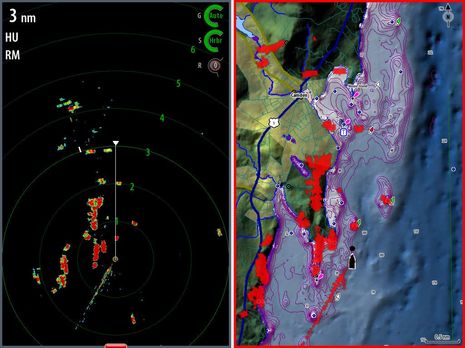 Below is the Raymarine C140W, which now has the new RD418HD attached. I’m really liking the true color echos, and it’s painting Mt. Battie well at 3-5 nm, but it and the BR are pretty comparable within the 3 nm circle they’re optimized for.
Below is the Raymarine C140W, which now has the new RD418HD attached. I’m really liking the true color echos, and it’s painting Mt. Battie well at 3-5 nm, but it and the BR are pretty comparable within the 3 nm circle they’re optimized for.
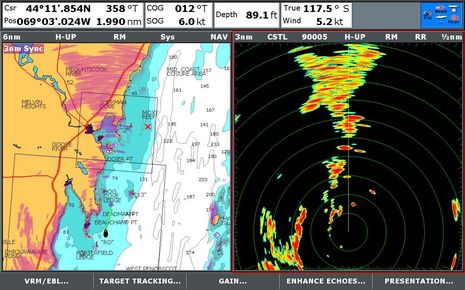 And here’s the Garmin 5212 now showing imagery from a 24HD. Photos almost never look as good as screen shots, and this is no exception, but I’m not really noticing a significant resolution improvement from the bigger dome. I think the 18HD screen would look similar here, not super but not bad. I’m also closer to the can buoy by this time, but it’s still targeting well.
And here’s the Garmin 5212 now showing imagery from a 24HD. Photos almost never look as good as screen shots, and this is no exception, but I’m not really noticing a significant resolution improvement from the bigger dome. I think the 18HD screen would look similar here, not super but not bad. I’m also closer to the can buoy by this time, but it’s still targeting well.
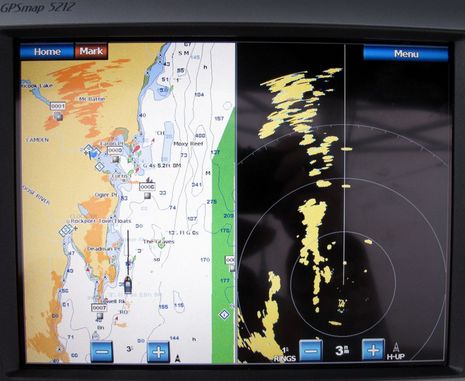 And, finally, here’s the Furuno MFD12/DRS2 combination, even closer to the can, but still nailing it. Note that both the Garmin and Furuno can also overlay radar on 3D charts, a feature I’m learning to like a lot, and a “best of” subcategory I forgot.
And, finally, here’s the Furuno MFD12/DRS2 combination, even closer to the can, but still nailing it. Note that both the Garmin and Furuno can also overlay radar on 3D charts, a feature I’m learning to like a lot, and a “best of” subcategory I forgot.
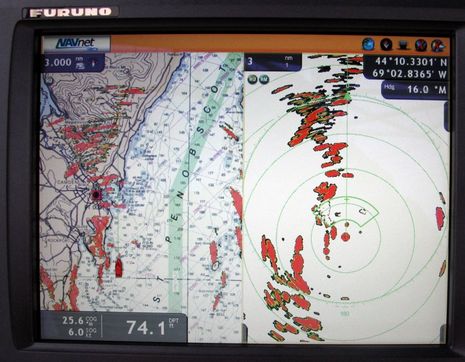 Ah, heck, one more, just because it’s cool. This is the new Raymarine 18″ HD in complete auto setting (like all the shots above), clearly showing rain showers down the Bay. While I haven’t actually been in rain with all these radars yet — I was trying here, but it slipped by — I think only the Furuno can match this. But the Furuno UHD 19 is notably expensive, I don’t know what the Ray 18 HD costs yet, and isn’t “value” a real, but quite subjective, “best of” variable.
Ah, heck, one more, just because it’s cool. This is the new Raymarine 18″ HD in complete auto setting (like all the shots above), clearly showing rain showers down the Bay. While I haven’t actually been in rain with all these radars yet — I was trying here, but it slipped by — I think only the Furuno can match this. But the Furuno UHD 19 is notably expensive, I don’t know what the Ray 18 HD costs yet, and isn’t “value” a real, but quite subjective, “best of” variable.


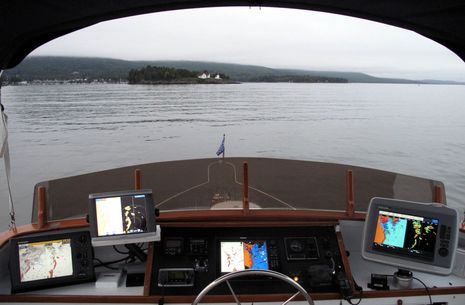
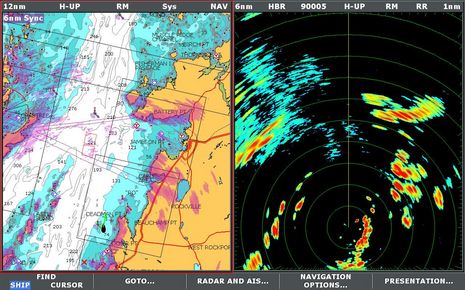
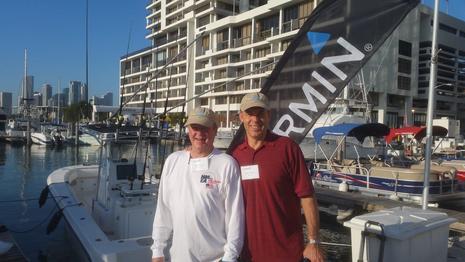










Noticed the RM is the new 418HD dome and not the 418D, do you what the difference is? I am waiting for the 424HD but can’t seem to get any idea of when the 418HD and 424HD will be available. I have an E120 MFD so I will stay with RM for the radar.
Thanks for the information.
From everything you have written we are pretty sure what the outcome will be for the categories of “best in depth”, “best feature comparison”, and best in marine electronics journalism as the wide range of new radar products make it into our many favorite magazines.
Weren’t you also reviewing the Lowrance? Too much stuff on the bridge? Thanks for the great articles.
Thank you, Dan. This radar stuff will be two different two-parters in Yachting (Oct. & Nov.) and Cruising World (Nov. & Jan.), three of which are written already.
Bob, I did test the Broadband BR24 with a Lowrance HDS-10, and also a Simrad NX 45, but I’m using the Simrad NSE now. It’s the best MFD of the three, but the radar looks pretty much the same on all the machines, aside from the higher res screen (which also makes better screen shots) and MARPA.
Mike, The 418D Digital was announced at Miami last winter and I think it’s been available all season. I used it in the early testing — see past screen shots — and it’s quite capable, especially for the price.
The 418HD was just announced, and the one I’ve got may be a pre-production unit. The cabling is the same, but the HD radome can spin up the 48 rpm, do dual ranges, true color, and maybe some other enhancements. Some of its features won’t be available until there’s a software upgrade, but I’m impressed with the true color. I don’t know the price yet.
Ben. You wrote ” This radar stuff will be two different two-parters in Yachting (Oct. & Nov.) and Cruising World (Nov. & Jan.)”.
I was going to ask what the difference between the two are, but I think the answer wouldn’t matter much, as I would be curious to read both. This will be the first time I read Yachting in a long while.
Ben, you mentioned MARPA.
1. Have, have you noticed, even if just generally, if the MARPA feature has become more effective at tracking targets ?
2. Has everyone kept that feature or has it been dropped in some cases ? Is ARPA or some interum step towards ARPA appearing in these products ?
3. Have the chartplotters modified or added features in their radar functionality to blend AIS targets in better with MARPA targets ? For example showing both AIS and radar targets in true bearing and speed, rather than MARPA for example giving relative bearing and speed ? Combining MARPA and AIS targets in a single list?
3. I believe you wrote very early on that one of the products displays radar targets that are stationary differently then moving, did that turn out to be unique to one product or do others have that ?
Ben what pitch would you make to Panbo readers to check out Yachting magazine? How would we find the marine electronics articles, yours and others, the same or different from Cruising World and other magazines ?
We’ve been using the Northstar M84 with a 2kw HD dome for two years now and for the most part have been really liked it’s color radar feature.
Just like your screen shot above from the Raymarine 18″ HD the Northstar M84 (when ours is working properly) displays a variety of colors for it’s return on the radar screen and the colors are related to the strength of the return. The darker the color the stronger the return. I have a couple screen shots I would love to send of some squalls we’ve tracked but don’t know how with this form (I’ll see if I can send it to you via an old email reply), but similar to the Raymarine example above where you see the rain the light blue would indicate light rain, yellow and orange heavier rain and red would indicate heavy down pours. When we’re out on the ocean making a crossing and if we can’t go around a squall we usually look for the weakest point in the squall to go through. One thing to keep in mind is that in dense rain it may be difficult if not impossible to see ship targets, they may be masked by the returns from heavy rain (both the ship and heavy rain being red). When using chart overlay the return is monocolor, ours is set to red. I don’t know if the Raymarine has this feature but the Northstar M84 give the option of choosing a variety of mono-colors for the radar display or a couple options of multi-color returns allowing the user to set the display to their own personal taste.
One thing I would love to see on the M84, and maybe other MFDs have this feature, is to be able to see waypoint indicators and AIS targets on the radar screen. They’re available obviously on the chart screen but it sure would be nice to have them displayed when using only the radar screen too.
Dan, My first Broadband Radar article is up at Yachting:
http://www.yachtingmagazine.com/article.jsp?ID=1000076368
It’s pretty different from the one coming out in Nov. Cruising World because I had more time with the gear, and more page space, and because sailors are more concerned with power and location issues.
I’m not going to tell Panbots what magazines they should read, but will say that I’m glad to be on the Yachting and Cruising World teams right now. Both are putting out meaty issues, I think, in a tough publishing environment. And, as I’ve noted before, Yachting is really a different, and better (in my opinion), magazine than it was a couple of years ago.
Entry on 18″ radome MARPA coming soon!
Ben, I need to add a second radar to my PDQ MV34
powercat ‘Dana Louise’ [you may have seen her in Camden this August on her mooring by the channel].
This will be an independent ‘clean sheet’ install with a mfd at the fly bridge helm and supporting radar over raster chart on my laptop at the helm below. Is that possible and what software hardware choices are there? Thanks, Brian
Hi Brian. Yes, I do remember your boat (from my hours of obnoxiously running up and down the channel testing radomes ;-).
I’m afraid there’s not much available in the way of integrated MFD/Radar/PC combinations. The most current choice has to be a Furuno NavNet 3D MFD8 or 12 up, with UHD radar, and MaxSea Explorer (coming out in the USA any minute now!) on the laptop. This should be a very powerful system, but it doesn’t come cheap. (I have all the components to try this setup on Gizmo and hope to hook them all together when I get back from Florida next week.)
The Nobeltec site talks about the IR2 Black Box, which lets an existing radar (and MFD) work with VNS or Admiral, but I’m not sure they still sell it. Similarly, Raytech software was designed to pick up radar and lots more from a Raymarine system, but I don’t think it’s been kept up to work with Ray’s latest systems.
But here’s a thought: Simrad’s new NSE MFD has VGA output and will soon (suppossedly) support USB keyboard/mouse input. If you had a component PC below, instead of a laptop, I think you could get its monitor and HID devices to run an NSE and radar above. That sort of setup may also be possible with a new Raymarine E-Series, though you’d have to use their STng keyboard, I think.
Maybe someone else has other ideas?
All Furuno NavNet 3D MFD have DVI and USB connector. Connect PC monitor to DVI and USB to mouse. By mouse you can in a very nice way control all functions of MFD. I can recommend it since it works perfect and cost almost nothing just a DVI cable and mouse. Standard gear from any pc store.
Great article Ben !
Ben, your article creates value in my mind for upgrading to the new scanner before my existing scanner reaches end of life.
Would it be fair to say that this level of improvement over the past generation of radar technology takes us pretty close too being able to share radar watching responsibilities with novice crew (and spouses) that don’t take an interest in using the radar until it’s needed (e.g. novice users who don’t take an interest on good weather days to compare the display to whats around them to really learn how to read it ?)
From the comparison shots above, the Garmin unit looks to be the only one that correctly pinged the 2 entrance bouys straight ahead a couple miles out(not the one at 1/2 mile). The Simrad looks like it pinged the first one, but missed the 2nd, and all the others don’t show either.
I have the Garmin 24hd onboard, and have noticed it does a really good job with bouys. It will improperly group a few boats which are close together into one blob, but it almost always separates small bouys. Not sure why that is…
I have an older Garmin 406 displayed on Garmin 3010’s; I like a lot of things that digital radar can do; I still like my 10″ Furuno CRT for 3 miles and under. To my eye, there is no comparison.
Ben,
I think the Furuno Radar range is taken from the Center of the radar to the top of the screen (Radius). So, accros the entire radar picture is 6NM? Comparing it to the Garmin picture it looks as if you are comparing a 6nm range on the Furuno to a 3NM range on the Garmin. If this is so the Furuno still nails targets at double the range of garmin?
Radar range always means along a radius from the radar, Brendan. A radar with a 24 mile maximum range should theoretically be able to see something (a big, hard something at least) 24 miles from your boat in any direction. In all the screens above, except the last one, the radars are set at 3nm range, and it means the same thing.
Where manufacturers differ is just how they scale ranges when putting radar into rectangular windows, look ahead mode, and synched with charts. There is not a right or standard way to do it, as far as I can tell. Note, for instance, how the Garmin shows 2 miles either side and 4 ahead, while several others show 3 each side and 6 or so ahead. Personally I like the way Garmin does it.
Ben does the dual range feature of the Raymarine 18″ HD work on your classic e-series after the software upgrade ?
Dan, according to the literature the answer is yes. But I sent the Classic E, the C Wide, and some other stuff back with Mark and Jim. While I’ve held onto the E for what seems a ridiculously long time…
https://panbo.com/archives/2005/05/nmea_2000_on_the_water.html
…I think it was valuable for my work, and for Raymarine.
However, I’m hoping to set up most all the MFDs now on Gizmo in the lab for winter testing, and, if you saw its current chaotic state, you’d agree that the decks must be cleared.
I can’t imagine how much work went into this.
Yes, it was valuable for Raymarine. I really wouldn’t have considered replacing my relatively new radar so soon, except for the big difference you could show us here on their newest HD product.
Without your piece I had it in the back of my mind that my next radar would be based on a solid state technology coming down to recreational radars and have been watching the SharpEye site for announcements.
Having spent entire days in the fog each of the last two years and having a close call in each case (would people please use radar relectors ?), I really want some better radar capability and a presentation that my crew can use (they don’t get enough practice to reliably follow my instructions with the existing analog radar) to relieve me. The closed radome is the only form factor that fits on my sailboat, and look forward to seeing a 24″ wide box under the Christmas Tree!
Dan said “would people please use radar reflectors?”
and last month Dan said:
I actually do use a nifty radar reflector, and you will be able to read about it if I ever find a print magazine to publish it.
Please tell us about it.
Thank you for your interest in the radar reflector piece, I have someone partially interested in publishing now, expect to have news soon.
This is a link to the product, an Echomax EM230I
Inflatable Radar Reflector.
http://www.landfallnavigation.com/sem230i.html
Although designed to be stored in a ditch bag and deployed for emergency use, this solves many problems for continuous use of a reflector on a cruising sailboat.
Even in poor weather, expected fog, or actual fog conditions, I encounter less than 1 in 50 boats with a reflector in use.
Radar refectors have a very negative image of providing too little effectivness for the trouble it takes to use them. This product effectively provides some additional radar return for so little trouble I hoist it almost always (except when I race on a clear day).
The article as drafted is a review of the various issues around radar reflectors that keep them in storage rather than use (like my original Davis Echomaster was), issues reducing their performance (e.g. no substitute for large size, user error / need to be positioned correctly) and an on the water review of this product on my boat since I purchased it 3+ years ago.
This is a confusing topic as the designs and tradeoffs between various products is vast, and there exists wild claims and useless products in this space as well. I think the article cuts thru the confusion, makes the case that we need not give up on passive reflectors, and should not as I believe radar is still the main tool for collision avoidance.